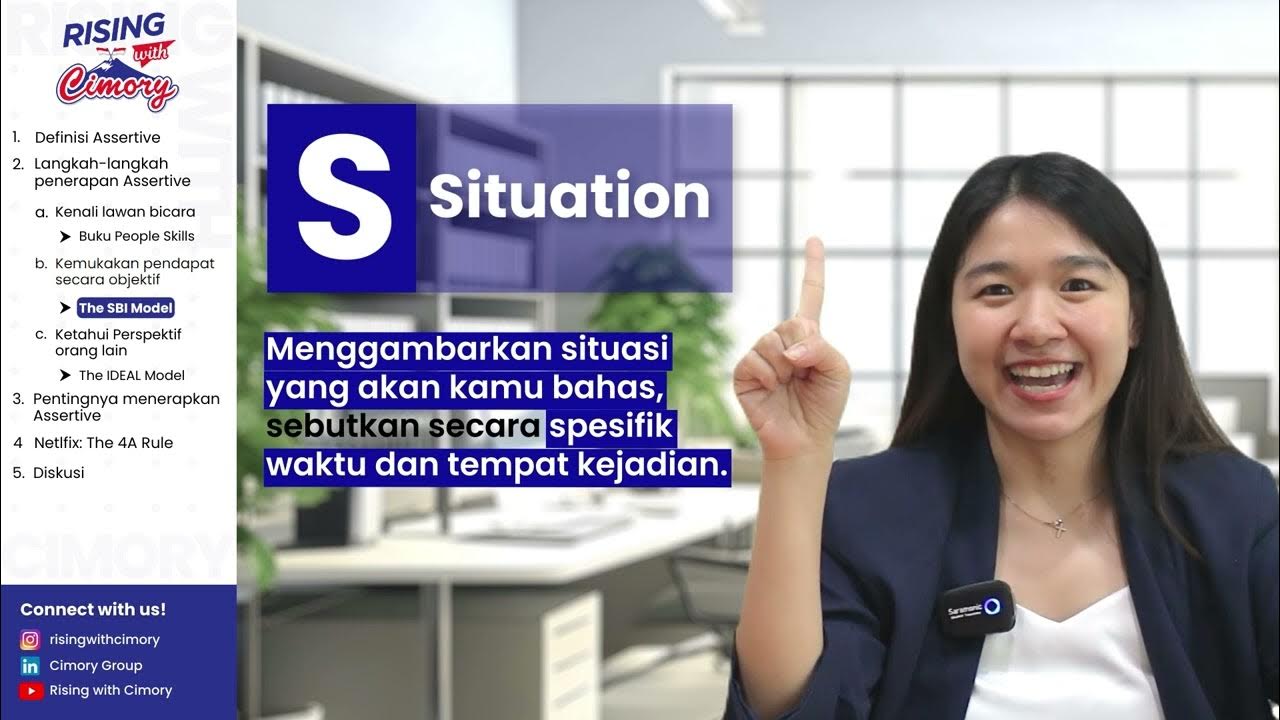Sikap Dan perilaku Asertif
Summary
TLDRThis video explores assertive behavior, emphasizing its importance in effective communication. Assertiveness is defined as the ability to express thoughts and feelings while respecting others' rights. Key traits of assertive individuals include clear communication, emotional control, and the ability to advocate for themselves. The video contrasts assertive behavior with non-assertive and aggressive behaviors, highlighting the negative impacts of the latter. An illustrative case study demonstrates a leader's transition from aggression to assertiveness, improving his relationships and effectiveness. Ultimately, the video encourages viewers to practice assertiveness for better interpersonal interactions and personal growth.
Takeaways
- 😀 Assertiveness is the ability to communicate one's desires, feelings, and thoughts while respecting others' rights and feelings.
- 😀 Being assertive involves honesty about one's feelings and expressing needs without manipulation or harm to others.
- 😀 Assertive individuals feel free to express their emotions, know their rights, and can control their anger without suppressing their feelings.
- 😀 Aggressive behavior harms others and can involve blaming, humiliating, or verbally/physically attacking them.
- 😀 Non-assertive behavior results in failing to express feelings or beliefs, leading to unwanted negative responses.
- 😀 Key characteristics of assertive individuals include direct communication, the ability to start and end conversations effectively, and rejecting unreasonable opinions.
- 😀 Assertive people can express both positive and negative feelings appropriately and actively pursue their goals while accepting their limitations.
- 😀 Important aspects of assertiveness include self-disclosure, respect for others, honesty, directness, and social responsibility.
- 😀 Nonverbal communication, such as body language and tone, plays a crucial role in assertive behavior.
- 😀 Transitioning from aggressive to assertive behavior can improve personal effectiveness and relationships, as illustrated by the story of Hakim.
Q & A
What is assertiveness?
-Assertiveness is the ability to communicate one's desires, feelings, and thoughts to others while respecting their rights and feelings.
What are the key characteristics of assertive behavior?
-Key characteristics include freedom to express feelings, awareness of personal rights, emotional control, effective communication, ability to say no, seeking help, and having an active attitude towards life.
How does assertiveness differ from aggressive behavior?
-Assertiveness respects both one's own rights and the rights of others, while aggressive behavior often involves harming others through blame, humiliation, or threats.
What are some signs of a person who is not assertive?
-Signs include easily giving in, being overly sensitive or anxious, lacking self-confidence, and struggling to communicate with others.
What are the 10 key aspects of assertive behavior mentioned in the script?
-The aspects include self-disclosure, respect for others, honesty, directness, clarity in expression, non-verbal communication, social responsibility, and learning assertiveness as a skill.
Why is emotional control important in assertive behavior?
-Emotional control allows individuals to express their feelings logically without being reactive, which helps in maintaining constructive communication.
How can assertiveness enhance personal relationships?
-By fostering open and honest communication, assertiveness builds mutual respect and understanding, leading to healthier relationships.
Can assertiveness be learned, and how?
-Yes, assertiveness can be learned through practice and self-awareness. Individuals can improve their assertive skills by recognizing their rights, practicing clear communication, and managing their emotions.
What was the example used to illustrate the impact of assertiveness in leadership?
-The example described a company leader who transformed from being aggressive and authoritarian to assertive, improving his leadership effectiveness and relationships with his colleagues.
What is the ultimate goal of practicing assertiveness?
-The ultimate goal is to create effective communication processes and develop respectful, equitable relationships.
Outlines

Cette section est réservée aux utilisateurs payants. Améliorez votre compte pour accéder à cette section.
Améliorer maintenantMindmap

Cette section est réservée aux utilisateurs payants. Améliorez votre compte pour accéder à cette section.
Améliorer maintenantKeywords

Cette section est réservée aux utilisateurs payants. Améliorez votre compte pour accéder à cette section.
Améliorer maintenantHighlights

Cette section est réservée aux utilisateurs payants. Améliorez votre compte pour accéder à cette section.
Améliorer maintenantTranscripts

Cette section est réservée aux utilisateurs payants. Améliorez votre compte pour accéder à cette section.
Améliorer maintenantVoir Plus de Vidéos Connexes

4 Communication Styles - Passive, Aggressive, Assertive & Passive Aggressive

Pentingnya Komunikasi Asertif (Karena Kita Gak Bisa Baca Pikiran Orang Lain)

Collaborative: Assertive

Cara Membangun Komunikasi Efektif di Lingkungan Kerja (Bangun Lingkungan Kantor yang Baik)

SEARLE'S CLASSIFICATION OF ILLOCUTIONARY SPEECH ACT|ORAL COMMUNICATION IN CONTEXT

Interpersonal Communcation Skills
5.0 / 5 (0 votes)
